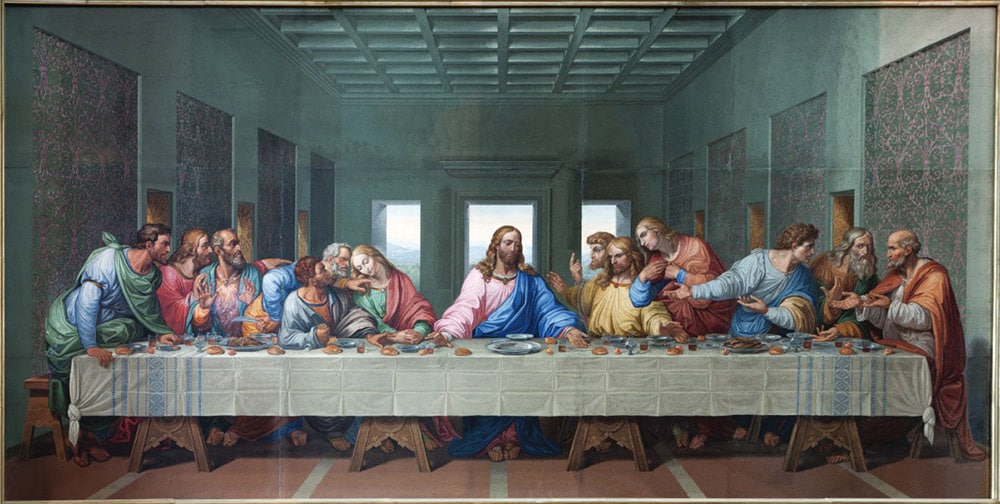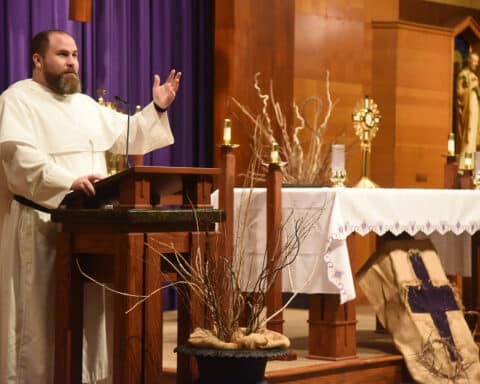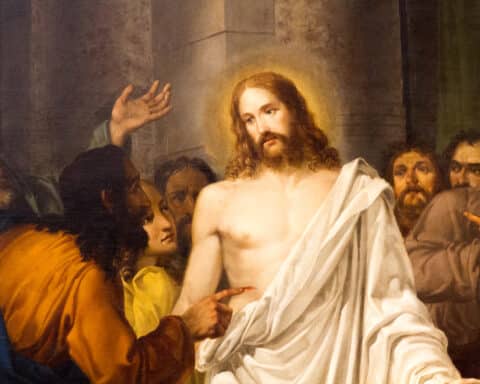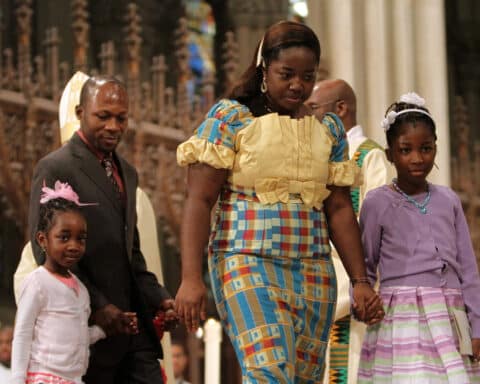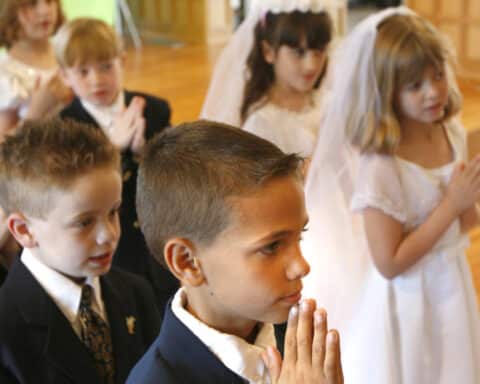President Abraham Lincoln’s proclamation inaugurating the annual celebration of Thanksgiving Day in the United States, in gratitude to God for his blessings, was dated Oct. 3, 1863 — right in the middle of the Civil War. One can only guess how many people, especially among those whose relatives had died in battle, questioned whether there were reasons to be thankful.
Lincoln, no doubt, wanted to stress that the terrible conditions of war did not obliterate the other realities of life. The defense of the union required extraordinary measures, but ordinary commerce and daily chores continued. Most people, spared the dangers of the battlefield, kept laboring at their crafts and tending to their families. Given these blessings, how could anyone fail to recognize God as their source and give him thanks?
But Lincoln knew that forgetting God was a powerful temptation — hence the reminder. Remembering God leads to hope, allowing people to see their lives in the broader context of eternal life. Those who had lost loved ones could look forward to a deeper peace and more lasting union with God. One could adopt a spirit of gratitude because God remains active in the world and draws mankind to himself. It is a truth that deserves, at the very least, an annual celebration of thanksgiving.
As we celebrate Thanksgiving once again, we would do well to heed the president’s words. We live at a time of intense polarization in matters of politics, religion and morality. Bitter disagreements fill the nation’s news media every day. Gratitude to God may be the last thing on people’s minds, yet his blessings can still be perceived for those open to his presence.
Believing in the Real Presence

The Catholic Church can bear witness to God’s presence in this climate, even amidst its own severe trial. The evil committed by bishops and priests, including sex abuse, corrupt use of power and greed have produced a truly dark moment. It’s hard to give thanks during this time. Many people have even walked away from the Church. Yet despite this terrible crisis, God is not absent.
The light that dispels the darkness continues to be God’s presence (cf. Jn 1:1-5). For Catholics, his presence is made palpable through the Eucharist, “the source and summit of the Christian life … [in which] is contained the whole spiritual good of the Church, namely Christ himself” (Catechism of the Catholic Church, No. 1324). Jesus’ words remain true: “I am with you always, until the end of the age” (Mt 28:20).
Jesus, of course, is present in various ways: in the Church, in the poor and sick, at Mass, in the person of the minister, etc. “But ‘he is present … most especially in the Eucharistic species‘” — the consecrated bread and wine (CCC, No. 1373). His presence in the Eucharist is called “real,” not “to exclude the other types of presence as if they could not be ‘real’ too, but because [his presence in the Eucharist] is presence in the fullest sense: that is to say, it is a substantial presence by which Christ, God and man, makes himself wholly and entirely ‘present'” (CCC, No. 1374).
Recent polls show that far too many Catholics neither believe nor understand this teaching. One could argue whether it’s a cause or an effect of the current crisis in the Church, but the way out of the crisis certainly includes a renewed appreciation of the Lord’s presence in the Eucharist. When due attention is paid to this most sublime gift, the blessings of God stand out more boldly, a spirit of thanksgiving results and new life within the Church and even society becomes possible. Indeed, it was only after the apostles, hiding in the upper room out of fear of being crucified, encountered the risen Lord that they broke forth in thanksgiving and shared the Good News with the world, even in the face of death.
To appreciate the truth of the Real Presence, one must begin with the words of Jesus in the Scriptures. Because we live 2,000 years after Jesus’ ministry, we also benefit from the Church’s consistent teaching on the Real Presence during the same time span, which, for the sake of this article, can be divided into three periods: the first 900 years, the period from A.D. 850 to 1600, and modern times. Based on this evidence, we may expect to find direction on what it means to live in the light of the Real Presence.
Jesus preached the Real Presence

Once Jesus began his public ministry, those who encountered him were amazed at his power and authority (cf. Mk 1:27-28). The Twelve Apostles dropped everything to become his disciples. As Jesus preached and performed mighty signs, great crowds followed him (cf. Mt 4:25, 8:1; Lk 14:25). Many wanted to make him king and hoped he would restore the eminence of Israel. But Jesus set his face on saving all people, from every nation. He said it would happen through a terrible, painful death. But he promised his disciples that he would be with them always.
The way Jesus would remain present puzzled his disciples. Jesus said it involved eating his body and blood. In fact, it was this teaching that raised objections among the crowds. “How can this man give us [his] flesh to eat?” (Jn 6:52). Jesus responds not by assuaging people’s concern, but by doubling down: “Amen, amen, I say to you, unless you eat the flesh of the Son of Man and drink his blood, you do not have life within you. Whoever eats my flesh and drinks my blood has eternal life, and I will raise him on the last day. For my flesh is true food, and my blood is true drink” (Jn 6:53-55).
Jesus’ words were so clear that “many [of] his disciples returned to their former way of life and no longer accompanied him” (Jn 6:66). The Twelve had no better idea than those who departed how Jesus would give them his body to eat, but they remained with him by faith (cf. Ecclesia de Eucharistia, No. 2).
It was only after the Resurrection, when they encountered the risen Lord and remembered his words, that the apostles (minus Judas) understood what Jesus had said (cf. Jn 2:22; Lk 24:8). It was the same for the two disciples walking to Emmaus who encountered the risen Lord along the way. At first they did not know it was Jesus, even as “he interpreted to them what referred to him in all the scriptures” (Lk 24:27). When they stopped for a meal, Jesus “took bread, said the blessing, broke it and gave it to them. With that their eyes were opened and they recognized him” (Lk 24:30-31).
The encounter features the same structure as the Mass: hearing the Scriptures and breaking the bread, or what we call the Liturgy of the Word and Liturgy of the Eucharist. The structure is found in the synoptic Gospels (cf. Mt 26:26-28; Mk 14:22-24; Lk 22:17-20) and First Corinthians as well (11:23-25). Called “institution narratives,” these passages established the Eucharist by Jesus’ command: “Do this in remembrance of me” (cf. 1 Cor 11:24).
After Jesus’ ascension the disciples began to devote themselves “to the teaching of the apostles and to the communal life, to the breaking of the bread and to the prayers” (Acts 2:42). In other words, they continued to perceive Jesus’ presence at Mass. Though they did not use the term “real presence,” they were convinced that they encountered the risen Lord, hearing his words and eating his body and blood.
The first 900 years of Christianity
The very first Christians, living in a dynamic relationship with the risen Lord, made quite a mark on society. Their way of life stressed love for each other and everyone else, including enemies. Many people were attracted by the joy and peace and mutual concern manifested in the lives of Christians. The numbers of believers increased, and the Faith continued to spread, even though during the first few hundred years Christians suffered persecution and martyrdom.
Constantine’s Edict of Milan (A.D. 313), which made Christianity legal in the Roman Empire, ended most persecution. Christians continued to celebrate the Eucharist and, until around the ninth century, enjoyed a period remarkably free from controversy regarding Christ’s presence. They took Jesus at his word, and they did not parse his presence at Mass in the same way future Christians would.
Regarding the Eucharist, all the early Church Fathers taught that the institution narratives, which were prayed at Mass, were to be accepted literally.
Having received the Lord and his many gifts, Christians could then share Jesus with others through love and service. The first 900 years of Christianity, while clearly setting the stage for a more theoretical articulation of the real presence of Jesus in the Eucharist, emphasized handing on the teaching of Christ and abiding in him.
The period from A.D. 850 to 1600
With the passing of almost a millennium, Christianity had grown exponentially, and its rites and teachings became part of the daily lives of Christians. With the Faith so settled, it is perhaps inevitable that interests and concerns would change. During A.D. 850 to 1600, the focus went from spreading the Faith to defending it.
Around the middle of the ninth century, a controversy regarding the Real Presence focused on the consecrated bread and wine. Opposing views took shape. Some said the Eucharist was the same body born of Mary. Others said it was the risen body seated at the right hand of the Father. Into this argument waded Berengarius of Tours (d. 1088), who, as in the latter position, emphasized the risen body of Christ. At the Sixth Council of Rome in 1079, Pope Gregory VII asked Berengarius to sign — and Berengarius did — a profession of faith that declared the Eucharist to be the true body of Christ born of Mary, which sits in heaven.
Later, Alan of Lille added the concepts of “accident” and “substance” to express the distinction between the appearance of bread and wine and the reality of Jesus’ body and blood. St. Thomas Aquinas adopted Alan’s words and, in a sense, canonized the terms. Meanwhile, with such intense focus on the Eucharistic species, people in the pews became more spectator than participant at Mass, to the point of not even receiving the Eucharist.
The next major moment comes with the Council of Trent, which met during 1545 to 1563. The council recognized the lack of participation by the people and encouraged them to receive Communion. But the main concern centered on answering the criticisms of the Protestant Reformation, especially those of major reformers, including Martin Luther, Huldrych Zwingli and John Calvin.
Trent responded with the following dogmatic definitions. For “presence”: In the sacrament of the Eucharist “the body and blood, together with the soul and divinity, of our Lord Jesus Christ and, therefore, the whole Christ is truly, really, and substantially contained” (CCC, No. 1374). For “transubstantiation”: “By the consecration of the bread and wine there takes place a change of the whole substance of the bread into the substance of the body of Christ our Lord and of the whole substance of the wine into the substance of his blood” (CCC, No. 1376).
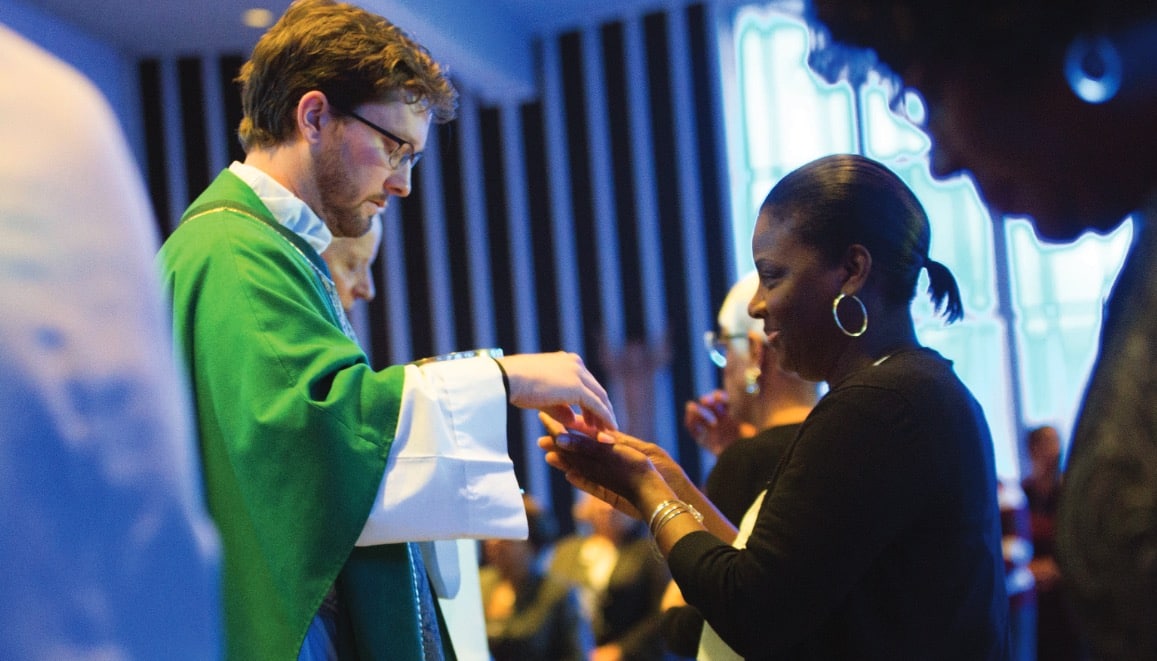
The modern period
The Church’s teaching on the Real Presence has not changed in the modern period. But new challenges have arisen: the widespread disbelief in the Real Presence and the infrequent attendance at the Sunday liturgy among Catholics.
These challenges, though still persisting, have been answered by the Church through various magisterial documents. Three are particularly helpful in considering the Real Presence: Sacrosanctum Concilium (1963), Mysterium Fidei (1965) and Ecclesia de Eucharistia (2003).
Sacrosanctum Concilium, or the Constitution on the sacred liturgy, is one of the documents composed at the Second Vatican Council. It teaches that Christ is present in all the Church’s liturgical celebrations “but especially under the Eucharistic species” at Mass (No. 7). In order to reverse the trend of people being “silent spectators” (No. 48), the Mass was to be revised to achieve more easily the “devout and active participation by the faithful” (No. 50). The revision would include a “richer fare” of biblical readings (No. 51) and the use of the people’s “mother tongue” (No. 54). Sacrosanctum Concilium does not focus on the Real Presence, but it readies the people to perceive that mystery.
Two years after Sacrosanctum Concilium, Pope St. Paul VI reflected directly on the Real Presence in Mysterium Fidei. He does not offer a new teaching. Rather, he reaffirms and refers the faithful to the Council of Trent’s teaching on the Eucharist (cf. Nos. 24, 45-46).
Paul VI, however, did contribute a helpful clarification. While Jesus is present to the Church in various ways, he is present in the Eucharist in “a way that surpasses all the others” (No. 38): It is a real presence. This “presence is called ‘real’ not to exclude the idea that the others are ‘real’ too, but rather to indicate presence par excellence, because it is substantial and through it Christ becomes present whole and entire, God and man” (No. 39). What looks and tastes like bread and wine is now the real presence of Jesus: He is “present whole and entire in his physical ‘reality,’ corporeally present, although not in the manner in which bodies are in a place” (No. 46).
In Ecclesia de Eucharistia, Pope St. John Paul II also confirms the constant teaching of the Church on the Eucharist. Like Paul VI he directs readers to the Council of Trent, but he also recommends Mysterium Fidei (cf. No. 9). John Paul II echoes Paul VI in lamenting the lack of understanding of and devotion for the Eucharist, particularly its “sacrificial meaning” (No. 10). With Ecclesia de Eucharistia, he aims to rekindle “amazement” for the Eucharist (No. 6).
How to live in the light of the real presence
Ecclesia de Eucharistia sends us back to the Scriptures, which remain the foundational documents of our faith. They must also be our main reference point when deciding how to live in the light of the Real Presence.
| PRAYER FOR THANKSGIVING |
|---|
|
Almighty God,
we, your children, gather round our tables
this Thanksgiving
mindful of you.
The food and drink, the company of family and friends,
and all the stories we share,
recall your love, made present to us through Jesus.
May we give you thanks always
at the table of your Son
who offers his words and body and blood
for our salvation.
In him
may we anticipate your kingdom
through love and service now.
We ask this through the same Christ our Lord. Amen.
— David Werning, written for Our Sunday Visitor |
John Paul II notes that, whereas the synoptic Gospels recount the institution of the Eucharist, the Gospel of John brings out its “profound meaning” (No. 20). Knowing “that his hour had come to pass from this world” (Jn 13:1), Jesus gathers his disciples for a last supper and teaches them how to follow him. He removes his outer garments and washes the disciples’ feet — a job reserved for slaves. Then he says:
“Do you realize what I have done for you? You call me ‘teacher’ and ‘master,’ and rightly so, for indeed I am. If I, therefore, the master and teacher, have washed your feet, you ought to wash one another’s feet. I have given you a model to follow, so that as I have done for you, you should also do” (13:12-15).
John’s account of the washing of the feet provides a model for living in the truth of the Real Presence. If Jesus remains with us in the Eucharist, offering himself as our nourishment, and we receive the gift well, then with him we can love this world and anticipate the next. It is, perhaps, the best way to manifest one’s appreciation of the Real Presence (cf. Mysterium Fidei, No. 69).
We can do all those things Jesus taught us: feed the hungry, clothe the naked, forgive one another, grant mercy, work for justice. And we should give thanks. It’s true that we live at a time of great crisis in the Church (and in society), and therefore we experience sadness, disappointment and maybe even anger. May such feelings move us to conquer evil with the good rather than turn us away from Jesus and all his gifts.
As President Lincoln reminded the nation in the midst of the Civil War: Remember the blessings of God and be grateful for his providence. St. Paul offers similar advice: “In all circumstances give thanks, for this is the will of God for you in Christ Jesus” (1 Thes 5:18).
The Catholic Church has never ceased proclaiming the Real Presence of Jesus in the Eucharist, which Christ himself revealed. It remains the pledge of his fidelity. He is with us now and forever. Blessed are those who hear his word and act on it.
David Werning writes from Virginia.
| The Real Presence Through the Ages |
|---|
|
“I have no taste for corruptible food nor for the pleasures of this life. I desire the Bread of God, which is the flesh of Jesus Christ, who was of the seed of David; and for drink I desire his blood, which is love incorruptible.”
— St. Ignatius of Antioch (d.c. 107)
“The bread … is at first common bread; but when the mystery sanctifies it, it is called and actually becomes the body of Christ. … So too the wine.”
— St. Gregory of Nyssa (d. 395)
“That Bread which you see on the altar, having been sanctified by the word of God is the body of Christ. That chalice, or rather, what is in that chalice, having been sanctified by the word of God, is the blood of Christ.”
— St. Augustine (d. 430)
“If … the Word of God himself willingly became man and made flesh for himself out of the most pure and undefiled blood of the holy and ever Virgin, why should he not be capable of making bread his body and wine and water his blood?”
— St. John Damascene (d. 749)
“In this world I cannot see the Most High Son of God with my own eyes, except for his most holy body and blood.”
— St. Francis of Assisi (d. 1226)
“O man, what has your God left you? He has left you himself, wholly God and wholly man, concealed under the whiteness of bread.”
— St. Catherine of Siena (d. 1380)
“My Jesus! What a lovable contrivance this holy sacrament was — that you would hide under the appearance of bread to make yourself loved and to be available for a visit by anyone who desires You!”
— St. Alphonsus Liguori (d. 1787)
“The soul hungers for God, and nothing but God can satiate it. Therefore He came to dwell on earth and assumed a body in order that this body might become the food of our souls.”
— St. John Vianney (d. 1859)
“This is the wonderful truth, my dear friends: the Word, which became flesh 2,000 years ago, is present today in the Eucharist.”
— Pope St. John Paul II (d. 2005)
|

